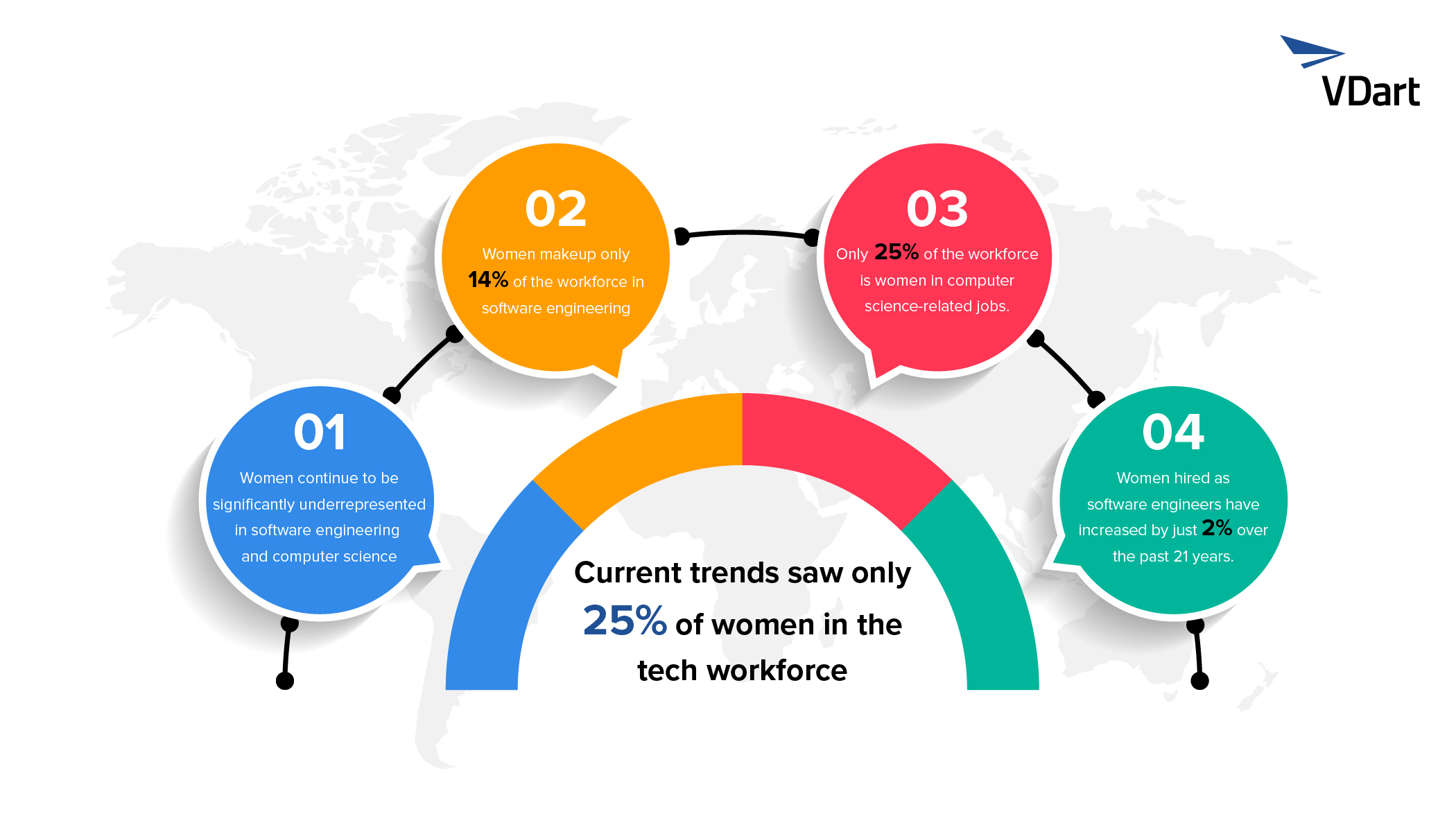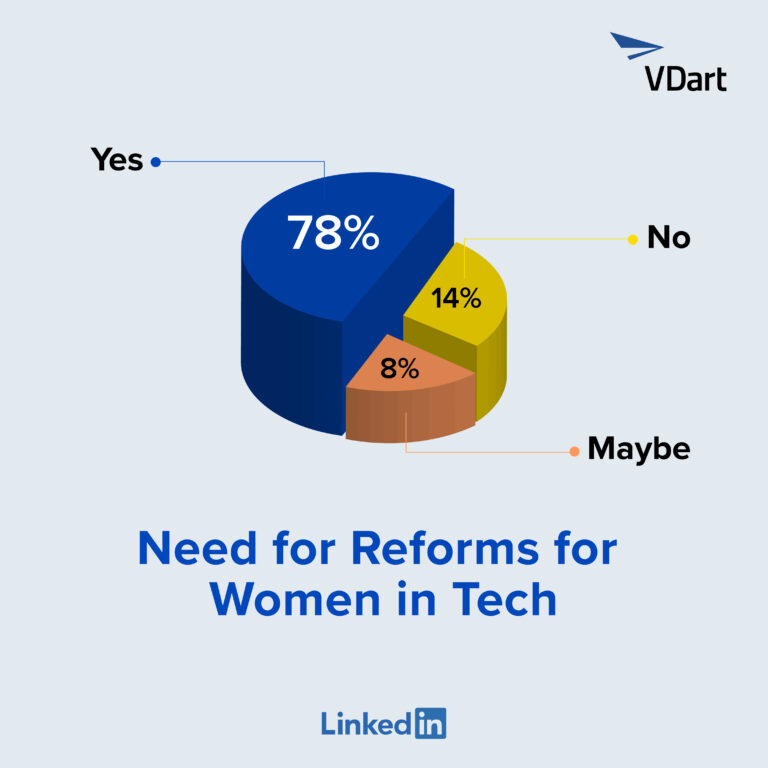The tech space is continuously expanding with technological developments, but to say the same for the growth of opportunities for women is questionable. Let’s not beat around the bush and admit that the tech space lacks gender diversity and that the sector just doesn’t provide enough opportunities for women compared to the other sectors like – finance, real estate, legal, manufacturing, and more.
Current trends saw only 25% of women in the tech workforce; breaking it down further,-
- Women continue to be significantly underrepresented in software engineering and computer science, despite the latest developments
- Women makeup only 14% of the workforce in software engineering and,
- Only 25% of the workforce is women in computer science-related jobs.
- Number of women hired as software engineers have
- by just 2% over the past 21 years.

Understanding the gender gap: why women are underrepresented in the tech workforce?
To understand the underrepresentation of women, we must consider the attributes that have been the contributing factors, including systemic biases, cultural norms, and historical trends.
Further diving deeper into the reasoning and talking to women in tech, we could prod upon the bias that tech has always been the big boys club, and it’s been difficult for women to carve a path for themselves.
Most of them have felt that there was an unconscious bias from hiring managers and executives that led them to favor male candidates, despite having similar qualifications to their male counterparts.
The underrepresentation is not just limited to the bias; there are several other facets, like –
- Lack of female role models in the tech field: With little or no women to look up to in the leadership, the top brass of positions or for mentorship has made it difficult for women and discouraged them from actively participating in the industry.
- Socio-cultural norms and stereotypes: The social and cultural stereotypes that suggest that technology and engineering fields are better suited for men have discouraged females from pursuing careers in tech, making it harder for women to pursue these careers to succeed.
- Lack of skills and knowledge due to limited resources: Less available resources and expertise due to biases and stereotypes have ensured that women are less likely to take education opportunities in the STEM fields and pursue careers in tech
- Lack of flexibility: Many tech jobs require long hours and inflexible schedules, which are barriers for women responsible for caregiving and other family obligations.
- Workplace culture and policies: With men at the helm of policy affairs, offices are often dominated by them, creating an unwelcoming scenario and making it difficult for women to feel comfortable and valued in their jobs, which can lead to lower retention rates for women in tech.
With several factors contributing to the gender gap, it becomes necessary to eliminate the barriers. But, the primary question remains about how we stop the bias and create more opportunities for women in tech.
To better understand the matter, we asked the women in our conversation about how they foresee the future. And the more we talked to women, the deeper we understood that the improvements are in progress, but there are miles to go before we see the disparity fade and women have the opportunities to flourish.
Giving more insights and talking about the journey, Shalini Khanna, the Director – Digital Transformation and Consulting at VDart, shares- “ Gender equality is still a relevant topic and maybe not completely overcome, but with time, I do see big conglomerates and mid-market size companies within staffing taking a closer look at the fact that they want to focus more and more on the growth of women across various industries and a path for them to take on leadership roles.”
Shalini emphasizes the future, “I was always passionate about technology and focused on learning and growing myself personally and professionally after meeting many women in tech in various leadership roles, etc. The one thing they and I had in common was not to let those barriers stop us from our goal; the passion to accomplish those goals was front and center. I wait for the day when there will NOT be a distinction with phrases like “women in tech” we are all human, and by that virtue as a person, we should all be on an equal playing field.”
The need for a level playing field will ultimately make a difference, but how to attain it is the ultimate question. The answer lies with —-
- Hiring managers
- Recruiters,
- Companies
- Business
- diversity Managers
- Staffing Companies and
- Suppliers,
- Vendors.
Going a step further, we must also know the solutions, and we strongly advocate bringing reforms in the industry as the first step
We asked our audience on Linkedin, and 77% agreed that reforms are the most significant need of the hour, while 8% of the audience had a neutral opinion.

Before we proceed further, let me ask you the same question-: Is there a need for more robust and stringent reforms in the technology sector to give more opportunities to women?
While we await to hear your response, we understand that creating more space for opportunities of the hour and as one of the most trusted IT staffing agencies in the United States, serving clients across various industries, we are committed to the philosophy of providing diverse talents that enables our clients to deliver on their organizational and operational goals.
Our commitment to promoting diversity in technology is strong. As we look forward to the future, we look at the role of staffing companies in supporting women in the technology space.
Role of Staffing Companies in Supporting Women in Tech
Staffing agencies are vital in connecting job seekers with employers, streamlining the hiring process, and helping businesses find qualified candidates quickly and efficiently.
While finding talent, staffing companies can significantly contribute to eliminating the underrepresentation of women and simultaneously bring in much-needed reforms. Here are a few tried and tested methods from our experience and some suggestions for the future:-
1. Promote Diversity Hiring:
Diversity hiring is all about carrying out hiring activities based on merit, with special care taken to ensure procedures have reduced biases related to a candidate’s age, race, gender, religion, sexual orientation, and other personal characteristics.
Workplace diversity should be strongly encouraged as the top priority, and less emphasis should be placed on turnovers. This change can be driven by hiring managers, recruiters, companies, diversity managers, staffing companies, suppliers, and vendors.
We at VDart strongly advocate and promote diverse hiring practices for our customers and internal operations. Our recruitment teams have special projects for our customers where they have only to recruit diverse candidates and talents.
Moreover, all our team members have undergone unconscious bias training programs. We are also an equal opportunity employer with strong policies to promote diversity in our hiring practices.
Similarly, staffing companies can create and implement diversity and inclusion policies that encourage equal opportunity and fair treatment of all candidates. These policies should include measures to prevent discrimination and bias during recruitment and hiring.
2. Create more role models and opportunities for women in leadership roles :
Creating more women leaders in tech is essential to promote gender diversity and equality in the industry. Women have historically been underrepresented in the tech sector in terms of workforce participation and leadership positions.
Encouraging more women leaders and creating opportunities for women in leadership roles
In tech can serve as role models for other women who aspire to enter the field and help create a more supportive and inclusive culture.
To encourage more women in leadership roles, we just don’t say for our clients; we also do it intentionally in our internal program, Global Women’s leadership Initiative (GWLI), where we work to create more leadership opportunities for women’s career growth in the organization with a core focus on mentoring and sponsoring, personal and professional development, visibility and storytelling and creating a culture where women can thrive and succeed.
Having women leaders bring a different perspective and approach to decision-making, problem-solving, and innovation, which can lead to better outcomes and tremendous success for organizations.
Staffing companies can promote more leadership hiring for women and create an equilibrium where they can encourage more women.
3. Educate and offer training for growth and development :
Although the sad reality is that women in tech face a lot of discrimination programs, the other side of the coin is that there is also a lackluster of skills. However, the bridge between opportunities and gaps can be shortened by staffing companies.
Staffing companies can offer training and support programs to women in tech by including mentorship, coaching, and career development opportunities like boot camps, train and deploy programs, coding and programming workshops, providing scholarships and assistance, or organizing and sponsoring tech conferences which can help them build their skills and confidence, and advance in their careers.
Furthermore, offering support can also help reduce turnover rates for women in tech, as they are more likely to stay with a company that invests in their professional development.
4. Providing flexible work options:
Women in the workforce are primary caregivers and caretakers of families in most households worldwide, so they cannot work for long hours or need a more flexible schedule.
The reality is that the tech industry demands long working hours, which is one of the reasons women quit the tech workforce. Staffing companies can provide flexible work options, such as remote work and flexible schedules, to help women balance their work and family responsibilities.
Furthermore, flexible working times would help in attracting and retaining top talent, promote work-life balance, address the gender gap, and also encourage diversity and inclusion
5. Advocating for change:
Change begins at home, and staffing companies need to take a step forward and lead the change to create more opportunities for women in tech as they remain underrepresented in the industry, particularly in leadership roles.
By promoting diversity and inclusion, staffing companies can tap into an underutilized talent pool, help fill the skills gap, and create a more innovative and problem-solving workforce. Additionally, promoting women in tech is the right thing to do from a social responsibility standpoint and can positively impact a company’s brand reputation.
To advocate the change, Staffing companies can use their influence to support change in the tech industry, including policies and practices that promote gender equality and diversity.
Conclusion
The underrepresentation of women in the tech workforce is a complex issue that requires systemic changes to eliminate the barriers and create more opportunities for women. Factors such as bias, lack of female role models, sociocultural norms and stereotypes, limited resources, inflexible schedules, and workplace culture and policies have contributed to the gender gap, and it is high time that bias and discrimination must be challenged.
With that being said, there is progress on the road, but there is a long way to go to have equal representation and a level field for women in the tech workforce. We should focus more on promoting women in leadership roles and strive for a future where there is no distinction between “women in tech” and everyone has equal opportunities to succeed.